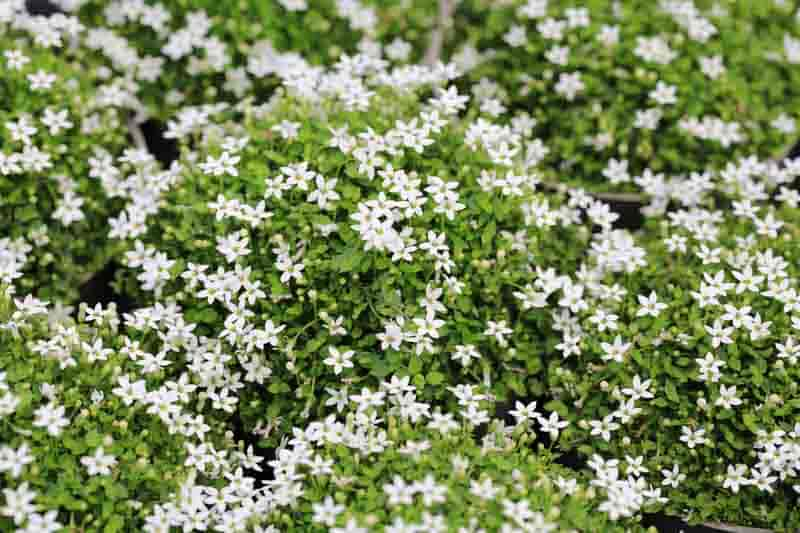Blue Star Creeper is a delightful addition to any garden, offering vibrant blue flowers and lush green foliage. Its low-growing habit and adaptability make it a favorite among gardeners for various landscaping purposes.
What is Blue Star Creeper?
Blue Star Creeper (Laurentia fluviatilis) is a perennial ground cover native to New Zealand and Australia. It belongs to the bellflower family (Campanulaceae) and is renowned for its star-shaped, sky-blue flowers. With its spreading habit and diminutive size, Blue Star Creeper forms a dense mat of foliage, making it an excellent choice for filling in gaps in pathways or between stepping stones.
Where Does it Grow?
Blue Star Creeper thrives in temperate climates and is suitable for USDA hardiness zones 5 to 9. It prefers partial shade to full sun and moist, well-drained soil. This versatile plant can be found gracing lawns, rock gardens, borders, and even as a charming accent in container gardens.
Planting Blue Star Creeper
Planting Blue Star Creeper is a straightforward process that yields rewarding results. Follow these simple steps for a successful planting experience:
- Prepare the Soil: Ensure the planting area is free of weeds and debris. Loosen the soil to improve aeration and drainage.
- Choose a Location: Select a site with adequate sunlight or partial shade, depending on your climate and preference.
- Spacing: Space Blue Star Creeper plants approximately 6 to 12 inches apart to allow for spreading.
- Planting Depth: Dig holes slightly larger than the root ball and place the plants at the same depth as they were in their containers.
- Watering: Water thoroughly after planting to settle the soil and provide moisture to the roots.
Watering and Maintenance
Proper watering and maintenance are essential for the health and vitality of Blue Star Creeper. Follow these tips to ensure your plants thrive:
- Regular Watering: Keep the soil consistently moist, especially during dry spells or hot weather.
- Mulching: Apply a layer of mulch around Blue Star Creeper plants to help retain moisture and suppress weeds.
- Pruning: Trim back any overgrowth to maintain a tidy appearance and encourage bushier growth.
- Fertilization: Feed Blue Star Creeper with a balanced fertilizer in the spring to promote healthy growth and flowering.
Blue Star Creeper Uses
Blue Star Creeper offers a multitude of uses in landscaping, including:
- Ground cover in shady areas
- Filler between pavers or stepping stones
- Edging along pathways or borders
- Accent plant in rock gardens or containers
Companion Plants
Pair Blue Star Creeper with these complementary plants for a visually stunning garden:
- Creeping thyme (Thymus serpyllum)
- Irish moss (Sagina subulata)
- Baby’s tears (Soleirolia soleirolii)
- Corsican mint (Mentha requienii)
Potential Issues
While generally low-maintenance, Blue Star Creeper may encounter some common problems:
- Overwatering leading to root rot
- Invasive spread in optimal conditions
- Pest infestations such as aphids or slugs
Pest Control
Combat pest issues by employing natural or chemical methods:
- Hand-picking pests like slugs or snails
- Applying insecticidal soap or neem oil for aphids
- Installing barriers to prevent unwanted spread
Disease Prevention
Prevent disease by practicing good garden hygiene:
- Avoid overhead watering to prevent fungal diseases
- Provide adequate spacing between plants for air circulation
- Remove and dispose of any diseased plant material promptly
Blue Star Creeper Propagation
Blue Star Creeper can be propagated through several methods:
- Division of established clumps in spring or fall
- Stem cuttings taken in summer
- Seed sowing indoors in late winter
Frequently Asked Questions
- Does Blue Star Creeper attract pollinators? Yes, Blue Star Creeper is a magnet for bees and butterflies, making it an excellent choice for pollinator-friendly gardens.
- Is Blue Star Creeper deer resistant? While not completely deer-proof, Blue Star Creeper is less palatable to deer due to its low height and dense growth habit.
- Can Blue Star Creeper tolerate foot traffic? Yes, Blue Star Creeper can withstand light foot traffic, making it suitable for pathways or areas with occasional stepping.
- How fast does Blue Star Creeper spread? Blue Star Creeper spreads moderately fast, forming a dense mat over time, especially in favorable growing conditions.
- Does Blue Star Creeper require pruning? Occasional pruning helps maintain Blue Star Creeper’s appearance and prevents it from overtaking other plants or areas.
- Can Blue Star Creeper be grown indoors? While Blue Star Creeper prefers outdoor conditions, it can be grown indoors in containers placed in bright, indirect light.
Conclusion
In conclusion, Blue Star Creeper is a versatile and charming ground cover that adds beauty and functionality to any garden landscape. With proper care and maintenance, this resilient plant will reward you with its delicate blue flowers and lush green foliage year after year.


